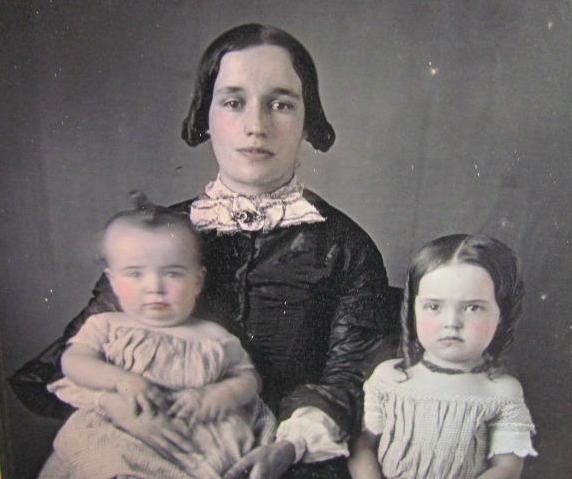
American Curls: Chronology

Figure 1.--This cased Daguerreotype portrait has been colorized. It shows an unidentified young mother with her two children. They look to be about 1/2-4 years old. It is a 1/4 plate Dag. We believe the portrait was taken in the 1840s. The baby does not have much hair, but what is there has been curls. The older child was probably a girl and has ringlet curls. We have found fewer boys with ringlets in the 1840s, but a few more in the 1850s. Our archieve is, however, too limited to make any definitive statement at this time.
|
|
The general pattern of curls has been for very young American children to have natural curls, both boys and girls. This was very common for girls, but also young boys had natural curls as well, especially in the 19th century. A treasured keepsake of many mothers in the 19th century was a hair bow and curly lock of hair. And this persisted into the 20th and 21st centuries as well. The major milestones in a boy's life in the 19th century were when he had his curls cut and when he was breeched, This might take place at the same time or different imes. Families varied as to which might come first. In the 20th century the convention of younger boys declined, but we still see younger boys wearing curls. Beyond this most boys had short hair, although there were periods in which curls, even ringlets curls were popular for boys (the late-19th century). Long hair again became popular for boys (late-20th century), but this did not include curls. We are able to follow this in some detail with the appearance of photography (mid-19th century). The style of curls also varied chronologically. The natural curls worn by very young children tended to be short because very young children tend not to have a lot of hair. As they get older there was more variety because mothers had more hair to work with. A complication concerning gender is that while girls most commonly wore elaborte curls like ringlets, during the time that ringlets were most common for boys, mothers often did not do their daughter's hair in ringlets. It was not unknown, but this was a common convention. While boys wearing ringles were most popular for a short period (late-19th century), we still see some ringlets after the turn-of-the century (early-20th century). We almost never see boys with ringlets after World War I in the 1920s). Really young boys, however, still often had natural curls. This varied over time, but has never disappeared. Girls' curls also varied over time. Because of Shirley Temple ringlets were particularly popular for girls in the 1930s.
The 19th Century
The general pattern of curls has been for very young American children to have natural curls, both boys and girls. This was very common for girls, but also young boys had natural curls as well, especially in the 19th century. A treasured keepsake of many mothers in the 19th century was a hair bow and curly lock of hair. And this persisted into the 20th and 21st centuries as well. The major milestones in a boy's life in the 19th century were when he had his curls cut and when he was breeched, This might take place at the same time or different imes. Families varied as to which might come first. In the 20th century the convention of younger boys declined, but we still see younger boys wearing curls. Beyond this most boys had short hair, although there were periods in which curls, even ringlets curls were popular for boys (late-19th century). We are able to follow this in some detail with the appearance of photography (mid-19th century). The style of curls also varied chronologically. The natural curls worn by very young children tended to be short because very young children tend not to have a lot of hair. As they get older there was more variety because mothers had more hair to work with. A major shift occurred after Mrs. Burnett published her book, Little Lord Funtleroy (1885). Before that boys might have curly hair, but not necessarily done in ringlets. A good example is Carl Schrader, a 5-year old Iowa boy in 1885. After publication of Little Lord Fauntleroy we see far more boys with ringlets. A complication concerning gender is that while girls most commonly wore elaborte curls like ringlets, during the time that ringlets were most common for boys, mothers often did not do their daughter's hair in ringlets. It was not unknown, but this was a common convention. While boys wearing ringles were most popular for a short period (late-19th century).
The 20th Century
Long hair again became popular for boys (late-20th century), but this did not include curls. We still see some ringlets after the turn-of-the century (early-20th century). We almost never see boys with ringlets after World War I in the 1920s). Really young boys, however, still often had natural curls. This varied over time, but has never disappeared. Girls' curls also varied over time. Because of Shirley Temple ringlets were particularly popular for girls in the 1930s.
HBC

Navigate the Boys' Historical Clothing hair style pages:
[Return to the Main American curl page ]
[Return to the Main American page]
[Return to the Main national boys' hair style page]
[Bangs]
[Ringlet curls]
[Hair bows]
[Curls]
[Caps]
[Collar bows]
[While long stockings]
[Stocking supporters]
[Underwear]
Navigate the Boys' Historical Clothing Web Site:
[Introduction]
[Activities]
[Biographies]
[Chronology]
[Clothing styles]
[Countries]
[Topics]
[Bibliographies]
[Contributions]
[FAQs]
[Glossaries]
[Images]
[Links]
[Registration]
[Tools]
[Boys' Clothing Home]
Created: 4:22 AM 5/10/2016
Last edited: 4:22 AM 5/10/2016



